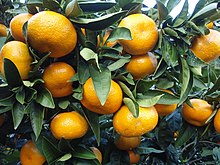温州蜜柑
温州蜜柑(学名:Citrus unshiu),又称蜜柑、无核橘,是芸香科柑橘属常绿灌木。
| 温州蜜柑 | |
|---|---|

| |
| 科学分类 | |
| 界: | 植物界 Plantae |
| 演化支: | 维管植物 Tracheophyta |
| 演化支: | 被子植物 Angiosperms |
| 演化支: | 真双子叶植物 Eudicots |
| 演化支: | 蔷薇类植物 Rosids |
| 目: | 无患子目 Sapindales |
| 科: | 芸香科 Rutaceae |
| 属: | 柑橘属 Citrus |
| 种: | 温州蜜柑 C. unshiu
|
| 二名法 | |
| Citrus unshiu | |
名称
编辑温州蜜柑一名始见于日本江户时代晚期,因被认为产于中国浙江的温州而得名,又被认为在九州肥后国天草郡西仲岛(现鹿儿岛县长岛町)变异而曾在九州称为仲岛蜜柑[2]。温州蜜柑经由日本传入西方世界,故以温州的日语发音“うんしゅう Unshū”得种加词“unshiu”。[3][4][5][6]
分类
编辑田中长三郎的分类法将温州蜜柑与橘划分为不同物种,而沃尔特·谭尼森·施永高的分类法视温州蜜柑为橘的变种。[7]遗传分析表明,温州蜜柑是高度自交的橘柚杂交种,其基因组有22%来自柚,多于大多数橘。其由含柚基因组少的黄陵庙或纪州变种(田中分类法为柑橘属橘种)同柚或其杂交种杂交,然后将所得品种与前者的另一种回交而得。[8][9]
特征
编辑温州蜜柑是极为甘甜的柑橘品种。[10]其通常无籽,大小与其他橘种相似。果皮松散,呈皮革状,比其他柑橘易剥。[11]外皮通常光滑或略粗糙,呈中小型扁平体球状。[12][13]通常有10至12个易分离、有韧膜的部分。[13]肉质脆弱。[11]果皮颜色通常取决于气候,潮湿地区成熟时可能仍是绿色,夜晚凉爽地区成熟时橙里透红。[13][14]
温州蜜柑耐寒,较冷地区果实在较冷时会更甜。成熟植株可在–9℃乃至–11℃的环境中存活数小时。[15]可食用柑橘品种中,只有金橘更耐寒。温州蜜柑少有刺,因此受人欢迎。[13]可用种子种植,首次结果大约需8年,也可嫁接至其他柑橘类砧木,如枳。[13]
历史
编辑温州蜜柑原产温州,唐代作为贡品,南宋韩世忠之子韩彦直曾于瑞安府任时著《橘录校注》(又称《永嘉橘录》《橘录》)系统介绍其品种与种植。明朝永乐年间日本僧人智惠将其带回九州鹿儿岛。1878年美国派日本特使罗伯特·布鲁斯·范·瓦尔肯堡将军夫人以日本产地萨摩(薩摩/さつま Satsuma)名之[16]。台湾北部于日治时期由鹿儿岛引进,亦有种植。
分布
编辑变种
编辑温州蜜柑的变种主要是橘。[18]此外还有一些杂交品种。
可能非杂交的品种
编辑杂交品种
编辑参考文献
编辑- ^ 米仓浩司; 梶田忠. Citrus unshiu (Swingle) Marcow.. 和名-学名インデックス(YList). 2003 [2020-06-08]. (原始内容存档于2021-03-20).
- ^ 「こたつでミカン」の光景はなぜ生まれたのか 冬の風物詩の盛衰、かつては迷信で避けられていた時代も. 佐藤成美: 3. 2019-02-01 [2021-06-30]. (原始内容存档于2019-02-05).
- ^ Schlegel, Rolf. Dictionary of Plant Breeding 2nd. CRC Press. 2009: 437 [2020-12-22]. ISBN 9781439802434. (原始内容存档于2020-11-06).
It's named after, Unsyu, China; in Japan it is known as "unshu mikan," in China, as "wenzhou migan"; recorded cultivation of the "wenzhou migan" date back some 2,400 years; it was listed as a tribute item for Imperial consumption in the TANG Dynasty; the best record of the cultivation of this variety in ancient China is from Jijia Julu, written by Han YAN, the governor of the region and published in 1178
- ^ Japanese Mikan and Satsuma Oranges. hawaii.edu. [2020-12-22]. (原始内容存档于2016-03-04).
Mikan is a tangerine-like citrus fruit that is grown in warmer regions of Japan in large quantities. Many different varieties have been introduced to Japan from China since the eighth century, but since the late 19th century the most important variety has been the unshu.
- ^ Citrus unshiu. Germplasm Resources Information Network (GRIN). USDA. [2017-12-11]. "probable origin in Kyushu islands, Japan or imported from China to Japan."
- ^ 御前明良. 紀州有田みかんの起源と発達史. 经济理论 (和歌山大学). 1999-11, 292: 97–118. (原始内容存档于2001-01-10) (日语).
【田中博士は永年にわたる調査から「温州みかん」は鹿児島県出水郡長島(現東町)が原産地である。中国浙江省や黄岩県から伝来していた「早桔」か「慢桔」または「天台山桔」類のミカンが長島で『偶発実生』したもので、時期は《江戸初期》のころ発現したものであろうと結論された】
- ^ Froelicher, Yann; Mouhaya, Wafa; Bassene, Jean-Baptiste; Costantino, Gilles; Kamiri, Mourad; Luro, Francois; Morillon, Raphael; Ollitrault, Patrick. New universal mitochondrial PCR markers reveal new information on maternal citrus phylogeny. Tree Genetics & Genomes. 2011, 7: 49–61 [2020-12-22]. doi:10.1007/s11295-010-0314-x. (原始内容存档于2021-01-22).
- ^ Wu, Guohong Albert; Terol, Javier; Ibanez, Victoria; López-García, Antonio; Pérez-Román, Estela; Borredá, Carles; Domingo, Concha; Tadeo, Francisco R; Carbonell-Caballero, Jose; Alonso, Roberto; Curk, Franck; Du, Dongliang; Ollitrault, Patrick; Roose, Mikeal L. Roose; Dopazo, Joaquin; Gmitter Jr, Frederick G.; Rokhsar, Daniel; Talon, Manuel. Genomics of the origin and evolution of Citrus (PDF). Nature. 2018, 554 (7692): 311–316 [2020-12-22]. Bibcode:2018Natur.554..311W. PMID 29414943. doi:10.1038/nature25447. (原始内容存档 (PDF)于2019-09-04). and Supplement
- ^ 清水德朗; 北岛宣; 野中圭介; 吉冈照高; 太田智; 后藤新悟; 丰田敦; 藤山秋佐夫; 望月孝子; 长崎英树; 神沼英里; 中村保一. Hybrid Origins of Citrus Varieties Inferred from DNA Marker Analysis of Nuclear and Organelle Genomes. PLOS ONE. 2016-11-30, 11 (11): e0166969. Bibcode:2016PLoSO..1166969S. PMC 5130255 . PMID 27902727. doi:10.1371/journal.pone.0166969. e0166969.
- ^ Elisa Bosley. In Season: Satsuma Oranges. CookingLight. [2015-02-25]. (原始内容存档于2021-03-20).
- ^ 11.0 11.1 Silvia Bautista-Baños; Gianfranco Romanazzi; Antonio Jiménez-Aparicio. Chitosan in the Preservation of Agricultural Commodities. Elsevier Science. 2016: 76 [2020-12-22]. ISBN 978-0-12-802757-8. (原始内容存档于2021-03-20).
- ^ frostowari. citrusvariety.ucr.edu. [2020-04-23]. (原始内容存档于2021-03-20).
- ^ 13.0 13.1 13.2 13.3 13.4 Andersen, Peter C.; Ferguson, James J. The Satsuma Mandarin. University of Florida Electronic Data Information Source. 2019 [2020-04-23]. (原始内容存档于2021-03-02).
- ^ 14.0 14.1 P. C. Andersen; J. J. Ferguson; T. M. Spann. HS195/CH116: The Satsuma Mandarin. ufl.edu. 2019-04-05 [2020-12-22]. (原始内容存档于2021-03-02).
- ^ "Orange Frost", a new cold hardy citrus. PLANTanswers. [2020-12-22]. (原始内容存档于2019-09-21).
- ^ 存档副本. [2018-02-22]. (原始内容存档于2018-02-23).
- ^ Saunt, James. Citrus varieties of the world : an illustrated guide 2nd. Norwich, England: Sinclair International Ltd. 2000. ISBN 1872960014. OCLC 45130256.
- ^ Barkley, NA; Roose, ML; Krueger, RR; Federici, CT. Assessing genetic diversity and population structure in a citrus germplasm collection utilizing simple sequence repeat markers (SSRS). Theoretical and Applied Genetics. 2006, 112 (8): 1519–1531 [2020-12-22]. PMID 16699791. doi:10.1007/s00122-006-0255-9. (原始内容存档于2021-03-09).
- ^ Kinkoji unshiu mandarin (graft) hybrid Citrus neo-aurantium. Citrus Variety Collection. University of California Riverside. [2020-12-22]. (原始内容存档于2014-10-22).
- ^ 菅原邦明; 大和田厚; 森口卓哉; 大村三男. Identification of Citrus Chimeras by RAPD Markers (PDF). HortScience. 1995, 30 (6): 1276–1278 [2020-12-22]. doi:10.21273/HORTSCI.30.6.1276. (原始内容存档 (PDF)于2021-03-20).